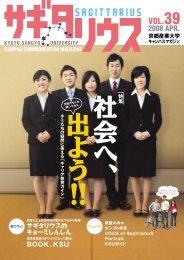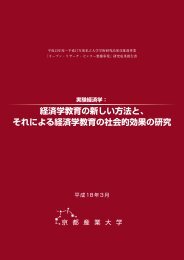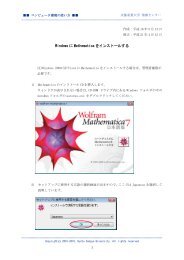GLOBAL JAPAN PROGRAM â Course Outlines (A â Spring ...
GLOBAL JAPAN PROGRAM â Course Outlines (A â Spring ...
GLOBAL JAPAN PROGRAM â Course Outlines (A â Spring ...
Create successful ePaper yourself
Turn your PDF publications into a flip-book with our unique Google optimized e-Paper software.
Attitude/Directivity(Lifelong Learning)<br />
Evaluation<br />
The contribution to class including attendance, group discussions (25%) is evaluated as well as the presentations<br />
(25%)and essays in English (25%) and the results of written examination(25%).<br />
Text and materials<br />
Reference materials: Herbert E. Plutschow, Historical Kyoto (the Japan Times. Ltd. 1983)<br />
Gouverneur Mosher, Kyoto – A Contemplative Guide (Charles E. Tuttle Company 1964)<br />
And other Japanese based materials<br />
Introduction to Japanese Culture B<br />
Lecturer: Hideko Tamoto<br />
<strong>Course</strong> Objectives<br />
Designed as part of the GJP (Global Japan Program), this course offers students the general view for the Japanese<br />
history, religion, the arts and culture by examining major historic sites - the world heritage - in Nara and others.<br />
<strong>Course</strong> description / plan<br />
Reading materials and audio-visual ones such as PowerPoint and video are applied in class. Group discussions and<br />
presentations are to be performed by students. Besides class a field trip is conducted. Active participation and<br />
preparations are welcome.<br />
1. The Japanese religion today<br />
2. The Shinto religion – Ise Grand Shrine<br />
3. Asuka Era - Horyuji Buddhist Temple<br />
3. Tempyo Era - Heijo-kyo Capital, Todaiji Buddhist Temple<br />
4. A field trip in Nara<br />
5. Group presentations by students (1)<br />
6. Group presentations by students (2)<br />
9. Quiz and discussions<br />
10. The Japanese architecture (1)<br />
11. The Japanese architecture (2)<br />
12. The Japanese Gardens (1)<br />
13. The Japanese Gardens (2)<br />
14. The Japanese paintings<br />
15. Examination<br />
7. Group presentations by students (3)<br />
8. Group presentations by students (4)<br />
Preparation and assignments<br />
Students are expected to read the handouts and some reference books and to submit the quiz of the class work.<br />
Special notes, cautions<br />
The class is an introductory course of Japanese history, religion and culture conducted in English.<br />
Expected outcome<br />
The course objective is to give both students from abroad and Japanese students the basic knowledge and the historical<br />
background of sites and festivals of Kyoto and to promote the cross-cultural communications between them. Special<br />
abilities to be attained: Logical Thought-Processing(Planning、Logical Analysis)、Practical Skills(Ability to Motivate<br />
others、Ability to Work Independently)、Communicative Skills (Ability to communicate Ideas to others、Language Ability),<br />
Attitude/Directivity(Lifelong Learning)<br />
Evaluation<br />
The contribution to class including attendance, group discussions (25%) is evaluated as well as the presentations (25%)





![Katalog der Ausstellung [pdf, 5663.6k]](https://img.yumpu.com/47907208/1/184x260/katalog-der-ausstellung-pdf-56636k.jpg?quality=85)




